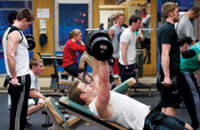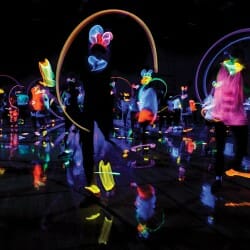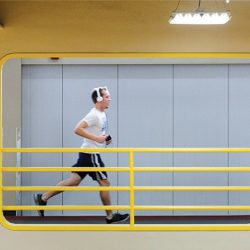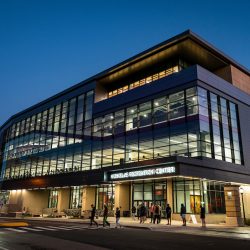Failing the Fitness Test
Recreational Sports Board asks for $60 million to pump up facilities.
When Cheryl Yeung x’10 hits the gym, she hits the books at the same time.
Like most UW students, Yeung is an accomplished multi-tasker. She has no problem cracking a book while monitoring her heart rate. Much tougher is finding an open cardio machine at the SERF (Southeast Recreational Facility). During peak hours, between 4 and 8 p.m., she needs to sign up to get on an elliptical trainer, treadmill, or stationary bike, and often must wait for one to become available. To beat the crowd, Yeung usually heads to the gym after 9 p.m.

Time for a relaxing workout? Not at the UW’s Natatorium, where students often have to stand in line for equipment. Photo: Bryce Richter
According to a report from the Recreational Sports Board, a faculty committee that advises campus officials, UW facilities no longer meet the fitness needs of students and staff. The board is recommending a $60 million expansion and renovation to the Natatorium, located on the west end of campus, to take some pressure off the SERF on West Dayton Street. A third option for students is the Camp Randall Sports Center, or the Shell, where cardio and weight machines crowd the edge of an indoor track.
“What we’re seeing now are students who live closer to the SERF going to the Nat because the SERF is too crowded,” says Recreational Sports Director Dale Carruthers. The proposed Natatorium facelift would increase fitness areas within the complex sevenfold by adding a large fitness center, four new gymnasiums, locker rooms, a four-lane track, and an indoor artificial turf facility. The addition would expand to the east, where the sand volleyball courts are located.
“We started talking about this in 2002, and we’ve done four different assessments over a five-year period,” says Carruthers, noting that several peer institutions, including Ohio State, Illinois, and Iowa, have recently built fitness facilities. “What we heard from our students is that they’re not satisfied with our indoor recreational facilities. They’re antiquated, and they’re too small.”
While the number of UW students hasn’t gone up much since 2000, their interest in health and wellness has, making the problem worse for facilities that can’t handle the demand. Some 85 percent of students report using recreational services, and facilities saw an increase of 26,395 visits in fall 2008 over fall 2007.
“Over the years, we noticed that there are fewer students who want to commit to a specific day and time for an activity. They want to come to the facility, jump on a treadmill for forty-five minutes or an hour, and get back to their studying,” Carruthers says.
In addition to mitigating stress, participating in recreational sports can help new students in particular acclimate to campus life. “It can be hard to find yourself on this campus,” Carruthers says. “This is a meeting place, where they make friends and forge bonds that extend well beyond graduation.”
The board hopes to get the proposal on a student referendum ballot by spring 2010. If approved, it could mean a student segregated fee hike of $60 per semester to pay for a project that probably wouldn’t be finished until 2014. Private funding could reduce the fees per student.
It’s a difficult time to ask for more money, admits Carruthers, adding, “The thing that impresses me about our students is their tremendous loyalty to this campus. They want to improve everything for future students that they can.”
Published in the Spring 2009 issue



Comments
No comments posted yet.